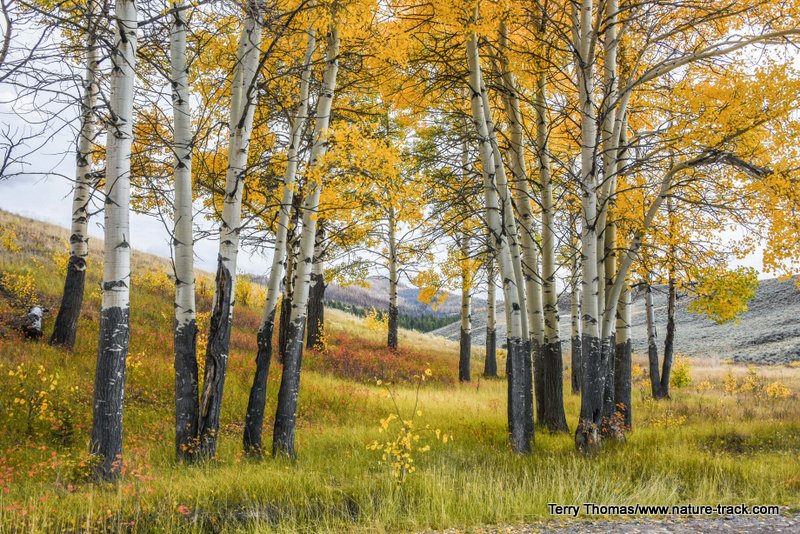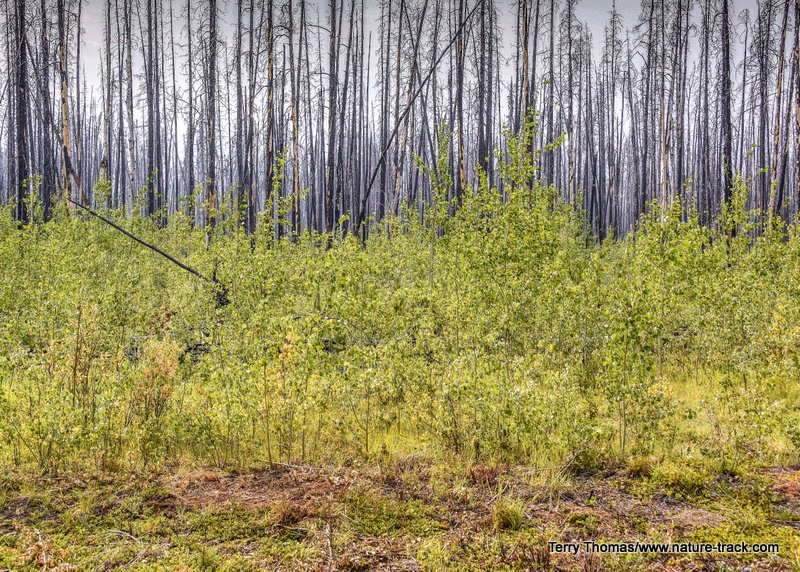Saving Aspen


The photo with the parklike look is pretty but demonstrates an aspen clone in trouble. The second photo shows the result of a fire that removed an overstory of conifers and allowed the aspens to thrive.
The Pando Aspen Clone on the Fish Lake National Forest in Utah is considered to be the world’s largest known DNA-tested organism. It’s estimated weight is 13 million pounds and its roots cover 106 acres with over 47,000 individual stems. The seed that started Pando likely hit the ground at the end of the last ice age, perhaps 20,000 years ago (some scientists estimate up to 80,000 years ago). Currently, some of the oldest trees in the clone are only 130 years old so it is obvious that tree stems have been growing and dying for thousands of years and Pando has been able to maintain itself.
Sadly, Pando may die on our watch. The clone is not regenerating, either sexually (by seed) or asexually (by root sprouting). It is not that the reproduction doesn’t occur, it is that it doesn’t survive. Fungus, insects, and bacterial infections continue to kill the adult trees as they have for thousands of years, but now nothing is replacing the dying stems.
Researchers are looking at several potential causes, but the number one thought is that the aspen sprouts are getting grazed or browsed off—mule deer, elk and livestock are the culprits—before they can establish.
The effects of browsing are easy to see in Lamar Valley of Yellowstone. Not long ago, it appeared that aspen habitats were going to disappear in Lamar Valley because of elk grazing. When the herd was at 15,000 animals, aspens seemed doomed. Predators, wolves, grizzly bears and humans, have helped reduce that number by two thirds. Now, aspen stands are expanding and new growth is evident.
There are two kinds of aspens in the West. Stable aspen stands are dominated by aspen and not prone to invasion by other dominant species. Healthy stable stands will have multiple aged trees, a dense understory of associated plants and fire and other disturbance is relatively uncommon.
The other kind of aspen is seral aspen. This type of aspen is part of a forest succession where conifer dominance is the climax vegetation. After a disturbance, usually fire, aspen thrive for around 80-100 years. During that time, conifer trees are reseeding and growing in the shade of the aspens. Eventually, they top over the aspen, a shade intolerant species, and aspens begin to wane. A disturbance of some kind is required to re-set the habitat clock.
In a natural system like this, fire has a rotation of 80-150 years, returning often enough to regenerate aspens before they wink out. With the advent of fire suppression, we have interrupted that cycle, threatening aspen regeneration.
Recently I reviewed a decision notice from the Ashton/Island Park Ranger District about a project to try to enhance aspen regeneration on over 42,000 acres from Island Park Reservoir to Ashton Hill. This project will use a variety of tools to “disturb” the status quo, from logging conifers out of aspen stands to prescribed fire, with the bulk of the project being fire. Grazing will be monitored to ensure sprouts have a chance to grow. This project won’t create 42,000 acres of aspen but will improve aspen stand health within those boundaries and help keep aspen on the landscape in Island Park.
We are witnessing one of the most spell-binding annual changes in nature—autumn. A key feature of autumn is the gradual and steady makeover of aspen from emerald to gold, transforming the landscape for a short season beyond awe-inspiring. What we do in the next 50 years will help determine if it will always be so.
Help Idaho Wildlife
When we traveled across the state in October 2017, we visited most of the Idaho Department of Fish and Game wildlife management areas. Most of the vehicles we saw using the wildlife management areas did not have wildlife plates. Buying wildlife plates is a great way for non-hunters and hunters alike to support wildlife-based recreation like birding.
C'mon folks, let's help Idaho's wildlife by proudly buying and displaying a wildlife license plate on each of our vehicles!
See below for information on Idaho plates. Most states have wildlife plates so if you live outside Idaho, check with your state's wildlife department or vehicle licensing division for availability of state wildlife plates where you live.
And tell them that you heard about it from Nature-track.com!

Wildlife License Plates
Great news! as of 2024, there are three NEW designs for license plates. They still are bluebird, cutthroat trout and elk, but they are beautiful.
Idaho Wildlife license plates provide essential funding that benefits the great diversity of native plants and wildlife that are not hunted, fished or trapped—over 10,000 species or 98% of Idaho’s species diversity. Game species that share the same habitats (such as elk, deer, antelope, sage-grouse, salmon, trout) also benefit from these specialty plates.
No state tax dollars are provided for wildlife diversity, conservation education and recreation programs. Neither are any revenues from the sale of hunting or fishing licenses spent on nongame species. Instead, these species depend on direct donations, federal grants, fundraising initiatives—and the Idaho Wildlife license plates.
Both my vehicles have Bluebird Plates. I prefer the bluebird because the nongame program gets 70 percent of the money from bluebird plates, but only 60 percent of the money from elk and trout plates - 10 percent of the money from elk plates supports wildlife disease monitoring and testing programs (to benefit the livestock industry) and 10 percent from cutthroat plates supports non-motorized boat access.
Incidentally, in 2014, the Idaho Legislature denied the Department of Fish and Game the ability to add new plates or even to change the name of the elk and cutthroat plates (very specific) to wildlife and fish plates, a move that would have allowed for changing images occasionally and generating more revenue. It would seem that they believe that we Idahoans don't want a well funded wildlife program.
I think it is time we let the Legislature know that Idahoan support wildlife funding and that we would like to see these generic plates come to fruition.

"WOW. What a phenomenal piece you wrote. You are amazing." Jennifer Jackson
That is embarrassing, but actually a fairly typical response to my nature essays. Since The Best of Nature is created from the very best of 16 years of these nature essays published weekly in the Idaho Falls Post Register (online readership 70,000), it is a fine read. It covers a wide variety of topics including humorous glimpses of nature, philosophy, natural history, and conservation. Readers praise the style, breadth of subject matter and my ability to communicate complex and emotional topics in a relaxed and understandable manner.
Everyone can find something to love in this book. From teenagers to octogenarians, from the coffee shop to the school room, these nature essays are widely read and enjoyed.
Some of the essays here are my personal favorites, others seemed to strike a chord with readers. Most have an important message or lesson that will resonate with you. They are written with a goal to simultaneously entertain and educate about the wonderful workings of nature. Some will make you laugh out loud and others will bring a tear to the eye and warm your heart.
Readers Write:
"You hit a home run with your article on, Big Questions in Nature. It should be required reading for everyone who has lost touch with nature...great job!" Joe Chapman
"We enjoyed your column, Bloom Where Planted. Some of the best writing yet. The Post Register is fortunate to have your weekly columns." Lou Griffin.
To read more and to order a copy, click here or get the Kindle version
Copies are also available at:
Post Register
Island Park Builders Supply (upstairs)
Barnes and Noble in Idaho Falls
Harriman State Park, Island Park
Museum of Idaho
Valley Books, Jackson Wyoming
Avocet Corner Bookstore, Bear River National Wildlife Refuge, Brigham City, Utah
Craters of the Moon National Monument Bookstore, Arco, Idaho